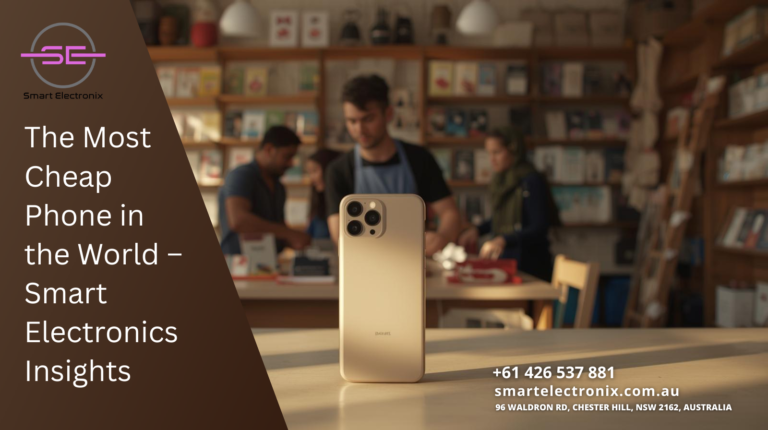
Ever found yourself browsing online and wondering if a functional smartphone could cost less than a cup of coffee? Believe it or not, the world of technology has reached a point where basic smartphones are incredibly affordable. At Smart Electronics, we love exploring gadgets that combine functionality with budget-friendly pricing. In this blog, we’ll dive into the most cheap phone in the world, its features, advantages, limitations, and how it’s changing access to mobile technology globally.
What Makes a Phone Cheap?
When we talk about the cheapest phone, it’s not just about the price tag. Several factors contribute to affordability:
- Hardware Specifications: Basic processors, minimal RAM, and smaller storage reduce manufacturing costs.
- Display and Design: Simple LCD screens instead of AMOLED or high-resolution displays.
- Camera Quality: Basic cameras with limited features.
- Software: Lightweight operating systems optimized for low-end hardware.
- Brand and Production Scale: Lesser-known brands or mass-produced models often have lower prices.
Despite being inexpensive, these phones still provide essential features like calling, messaging, basic internet browsing, and access to essential apps.
The Most Cheap Phone: Overview
Over the past decade, several ultra-budget phones have gained attention. Among them, the Freedom 251, launched in India, claimed to be the cheapest smartphone in the world, priced at approximately $4.50 USD. While this device received mixed reviews for build quality and performance, it demonstrated the possibilities of ultra-affordable technology.
Other affordable options include entry-level phones from brands like Nokia, Tecno, and Itel, ranging between $15 to $30 USD, offering essential smartphone features without breaking the bank.
Features You Can Expect from Ultra-Budget Phones
 Even the cheapest phones today can provide a surprisingly functional experience:
Even the cheapest phones today can provide a surprisingly functional experience:
- Basic Touchscreen: Most cheap phones have a small, 4-inch to 5-inch display suitable for browsing, messaging, and calling.
- Single-Core or Quad-Core Processors: Adequate for lightweight applications like WhatsApp, social media, and basic games.
- Minimal Storage: Usually 4GB to 16GB, often expandable via microSD cards.
- Basic Camera: Single-lens cameras for casual photography.
- Lightweight Operating System: Android Go or similar lightweight OS ensures smooth functioning on low RAM.
These phones focus on essential functions, making them ideal for students, senior citizens, or users in developing regions.
Advantages of Owning a Cheap Phone
1. Affordability
The most obvious benefit is the price. For just a few dollars, you can own a device that keeps you connected, without worrying about credit card bills or expensive installments.
2. Durability
Surprisingly, many ultra-budget phones are durable. Without high-end glass panels or delicate features, these phones can withstand drops and rough handling.
3. Accessibility
Cheap smartphones make technology accessible to people in rural or economically challenged areas. This promotes digital literacy, education, and communication.
4. Low Maintenance
With fewer apps, simpler hardware, and lightweight software, these devices require less maintenance and rarely encounter performance issues common in high-end smartphones.
5. Backup Device
Even if you own a premium smartphone, a cheap phone can serve as a reliable backup in emergencies, travel, or areas with higher risk of damage or theft.
Limitations of Ultra-Budget Phones
While they are highly affordable, cheap phones do have constraints:
- Limited Performance: Cannot handle heavy applications, multitasking, or graphic-intensive games.
- Basic Camera Quality: Photos may be grainy or lack detail.
- Smaller Storage: Limited space for apps, photos, and media.
- Battery Life: Often smaller batteries require frequent charging.
- Software Updates: Rarely receive long-term updates or new features.
Despite these limitations, these phones are excellent for basic communication and minimal smartphone use.
Tips for Choosing the Right Cheap Phone
- Focus on Core Features: Prioritize calling, messaging, and battery life over high-end cameras.
- Check Storage Expandability: Ensure there’s a microSD slot if you need more space.
- Evaluate Build Quality: Look for robust designs that can handle everyday use.
- Consider Brand Reputation: Even affordable models from known brands may provide better durability and software support.
- Read Reviews: Check user feedback on performance and reliability.
The Global Impact of Affordable Smartphones
Ultra-budget phones are transforming how people access technology worldwide. Students in rural areas can now access educational apps, small businesses can connect with customers through social media, and families can stay in touch at minimal costs. By lowering the entry barrier, cheap smartphones help bridge the digital divide, making communication and online access more inclusive.
Smart Electronics Tips for Buying Budget Devices

- Always buy from trusted sellers to avoid counterfeit or low-quality phones.
- Compare prices and features across multiple brands to find the best value.
- Prioritize battery life and connectivity features, especially if you live in areas with weak network coverage.
- Consider warranty and after-sales support, even for inexpensive models.
- Use lightweight apps to prevent overloading low-end hardware.
Conclusion
The most cheap phone in the world proves that technology is no longer a luxury, but a necessity accessible to everyone. While ultra-budget phones have their limitations, they serve as essential tools for communication, education, and digital access. At Smart Electronics, we recommend exploring these devices to stay connected without overspending. With the right choice, even the most affordable smartphone can make a significant impact on your daily life, productivity, and connectivity.
So next time you think a smartphone is out of your budget, remember: functional technology at a low cost is not only possible but increasingly common, thanks to innovations in affordable electronics.
